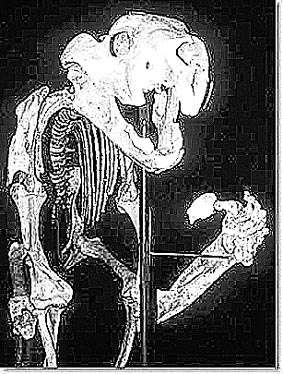
|
| ©SA Museum |
| Marsupial lion (thylacoleo carnifex) skeleton |
New evidence at Redbanks Conservation Park near Burra has confirmed that large marsupial lions roamed the area during the Ice Age.
When looking at today's native, mostly herbivorous, Australian fauna it is hard to imagine a land where savage meat-eaters roamed, but Thylacoleo carnifex was one of the largest marsupial carnivores to live on the continent.
Some small fossil remains of the animal had previously been found at Redbanks in the past which suggested the presence of the marsupial lion, but a recent find conclusively confirmed its existence.
"What was interesting was that it was actually found while Flinders University archaeologists were excavating one of the significant diprotodon (giant wombat) fossil sites," Department of Environment and Heritage district ranger Ian Falkenberg said on Friday.
"This one was found in the layer above the diprotodon fossils."
Believed to have been the size of a large wolf or leopard, and Australia's largest ever marsupial predator, thylacoleo carnifex had huge meat slicing cheek-teeth and retractable clawed opposable thumbs.
An Australian and Canadian research team from the Universities of Sydney and Guelph in Ontario said it had the most powerful bite of any known animal in the world, living or extinct, and was more closely related to the wombat than an African lion.
The marsupial lion became extinct some time within the past 45,000 years, but when it was alive its biggest prey would have been the diprotodon
The presence of the diprotodon in the Burra area has become the catalyst for the development of "fossil tourism" at Redbanks and the surrounding area, and the discovery of the marsupial lion is likely to enhance these plans.
"We are hoping to develop a program for commercial tour operation in Redbanks centred around fossil tourism and natural resource management issues," Mr Falkenberg said.
"We do have a program going at the moment, but we are hoping to take it to the next step with links with Burra Community School and TAFE, so we can instigate some training in the community for people who are interested in undertaking a commercial tourism operation, so they can obtain accreditation."
Mr Falkenberg said tours would look at the stories of the fossils at Redbanks and the changes in the landscape over thousands of years.
"We hope to encourage the community to get involved, and next month we will have an agreement with all the major stakeholders - South Australian Tourism Commission, TAFE, the school and the Regional Council of Goyder.
"We now need to develop strategies, with a pilot program to be available in the next two to three months."
There are plans to improve Burra's fossil display, currently housed in the local council foyer, with hopes of finding a new location where the collection can be expanded to help revitalise the fossil tourism component of visitor experience, adding another dimension to the heritage of the district.
"The next six months will be very interesting," Mr Falkenberg said.



Reader Comments
to our Newsletter